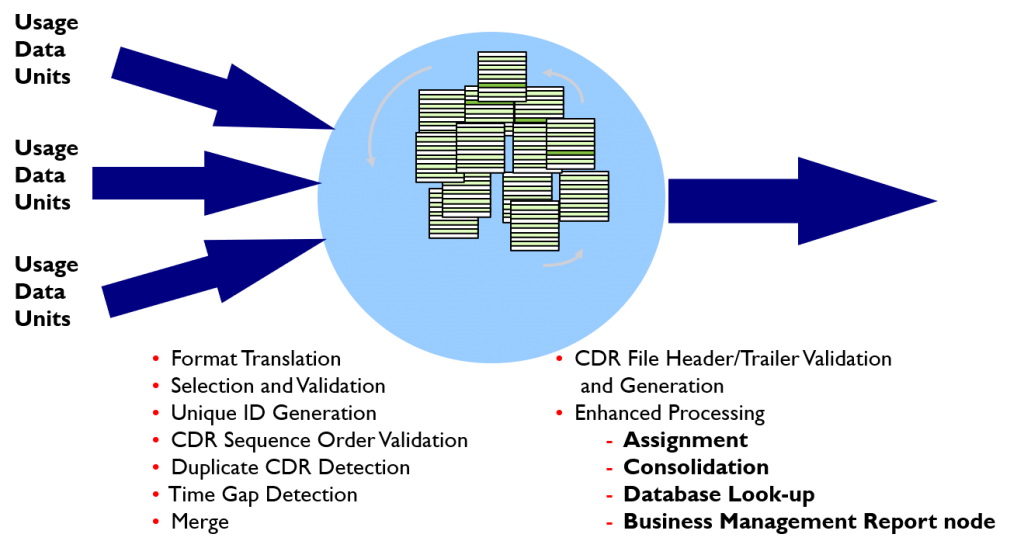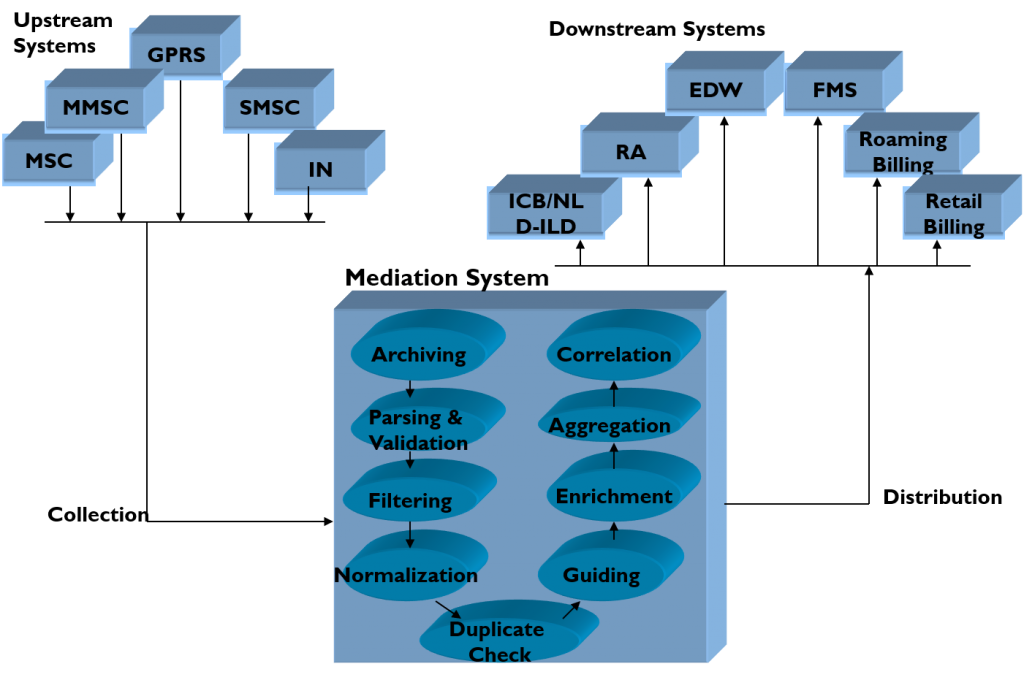Table of Contents
Mediation
Mediation is the process of collecting the files from network elements i.e. upstream, applying certain business rules and distributing to the various downstream applications.
Simply put, it’s about collection, processing, and distribution, but in actual terms it’s a quite complex task.
Mediation acts as an interface between the various network elements and down-stream systems like Billing, Interconnect Billing, FMS, RA, Data Warehouse, etc.
It is required to provide the useful data in expected format and removing the lot of discrepancies before handing it over to the downstream. Having a mediation system helps in centralizing this transformation function for different types of network elements and various business applications.
Process Flow in Mediation
Usage Records & Usage Data
- CDR (Call Detail Record)
A call detail record (also known as call data record or CDR) is the computer record produced by a telephone exchange containing details of a phone call that passed through it. - Important Fields
- Calling Party Number
- Called Party Number
- Calling Subscriber IMSI
- Chargeable Duration
- Time of Start Of Charge
- Record Type (Voice, SMS etc.)
- Switch-Id
- File Header and trailer -> Contains non call related data like:
- Total Number of records in the file
- Timestamp at which the file has been generated.
CDR Types
MOC : Mobile Originating Call
MTC : Mobile Terminating Call
SMMO : SMS Originating
SMMT : SMS Terminating
Transit : Interconnection (can be further segregated in Transit-In & Transit-Out)
CF : Call Forwarding
RCF : Roaming Call Forwarding (generated in home network for MT calls for outroamers.
MMSO : Multimedia Messaging Service – Originated
MMSR : Multimedia Messaging Service – Received
G-CDR : GPRS usage CDR generated at GGSN
S-CDR : GPRS usage CDR generated at SGSN
TAP-IN : Out Roamer CDRs (contains Voice, SMS and GPRS
TAP-OUT : In Roamer CDRs
CDR Data Formats
- ASN.1 – Abstract syntax notation 1
- It’s an International Standards Organization (ISO) data representation format used to achieve interoperability between platforms.
- Eg. ZTE MSC, Huawei MSC, Ericsson MSC Raw CDRs come in ASN.1 format.
- ASCII
- Eg. VAS CDRs
- TAP-3 – Transferred Account Procedure
- TAP is a collection of procedures used in GSM to send billing records of roaming subscribers from the visited mobile network to their respective home network operator.
- TD.35
- NRTRDE format specification, defines the file and record format to be used in the data exchange.
Processes in Mediation

Collection
The part of mediation system which brings the usage data files/CDRs into the system for further actions in the processing layer. Collection process is normally defined to run at a frequency of 5-10 minutes and keeps checking for any unprocessed files available at defined location for each source element.
Generally Mediation systems are capable of supporting all majorly used data transfer protocols like FTP, SFTP, FTAM etc.
Archiving
After collecting the input CDR files, a copy is saved at some specific location on the mediation server. This is only for record purpose and is maintained for a defined period. At this stage an ID is provided to the file by way of pre/postfixing some unique/sequential term to the filename. The archiving is done at both the input level and output level (before distribution of processed files). It is known as Input Archiving and Output Archiving respectively.
File Sequence Check
Input files are normally numbered in a sequence. The system can generate alert in case any sequence is missing or a duplicate filename is received. Files with duplicate filename is normally not rejected by the system and goes through the next check of being duplicate in terms of contents also.
File Duplicate Check
After a file is collected, it is checked for possibility of being duplicate. This is normally done by way of comparing the checksum value with certain available files in the system. Duplicate files are rejected by the system and no further processing is done after creating an entry in the log file. These can be further verified by backtracking to the original file.
Parsing and Validation
Based on file and record structure, input records are required to be parsed and validated. CDRs with incorrect data format should not be processed to ensure that only valid records are passed to the downstream. The record level validation is performed on some of the specific fields as per the solution requirements. If the record fails the validation then error is thrown with proper message.
Normalization
The CDR data that comes from the different network elements is in the different formats and record structure. There is the need of converting this data to a common format so that processing can be started. This is known as the Normalization and the CDR data as Normalized data. e.g. converting an ASN.1 data file into ASCII format
Record Sequence Check
Similar to the check applied on file, this checks is performed at record level. Alerts are generated for out of sequence records (which can help during auditing). This can help in identifying if some CDRs are missing and may also point to some possible fraud in which CDRs may be suppressed after usage generation in Network element.
Duplicate Record Detection
Same records must not be processed twice so the duplicate record detection is required. Duplicate record detection (also called DRD) happens based on some key fields called DRD key. Duplicate records are moved into a separate bucket and left unprocessed there-on.
CDR Filtering
As per the solution requirements, certain unwanted CDRs (which are not required by any downstream application) are dropped from the processing queue. For example, in case of an Indian operator, SMS-MT CDR from MSC was not required. For audit or reporting purpose, similar input was available from SMSC.
CDR Guiding
Current Mediation systems normally have rule based engines. Once we have the set of required CDRs, (after filtering) these are then guided into separate paths or mapped to different down-streams so that appropriate business logic can be applied there-on.
Record Enrichment
Some of the output record fields get populated from the database tables based upon the requirements. These tables are known as Reference tables in which the data is loaded as provided by the business. E.g. In the Input CDR the Circle ID is coming only not the complete circle name but as per the downstream, the name of circle is required. Then reference tables come into picture. The look up has been carried out for Circle ID as coming in the input CDR and the corresponding Circle name will be populated in the output CDR.
Aggregation
The process of aggregation is required when a long duration call is held. The corresponding CDRs are known as Partial CDRs. The partial records will be aggregated at the mediation system on the basis of the Record Sequence Number of there records. Particular time duration have been specified for these records which are known as Partial record assembly time window. There is a partial record assembly key which comprises of some fields of CDR. Partial records will be aggregated on the basis of one of the two conditions whichever gets fulfilled first: At every scheduled frequency of assembly if the last record of the call is received or when the partial record assembly time window completes.
Correlation
Each downstream system requires a specific set of information from network. Sometimes, this information may not be available from CDRs generated at a single network element and may be scattered at different places. In such cases, we need to correlate the records available at different systems and generate single output CDR. This can be handled by the process of correlation, which can be done by referring to Call Reference Id or a similar field. E.g. In case of data/GPRS CDRs URL is available at GGSN but billing related information is available at SGSN. In order to provide URL in output, we need to refer to both CDRs.
Error Messaging and Alarms
Proper error messages/alarms should be generated in case of discrepancies e.g. In case of a record failing reference data look-up, an alarm with proper error message should be generated and CDR should be moved into error bucket. Mediation systems also provide provision for correction of ref. data and/or CDR detail and re-processing.
Distribution
It is the process which distributes the processed files to various downstream according to selection rules for that stream.

Protocols:
- FTP
- FTAM
- Inter-Mediation
- Disk
Tasks
- Assigning a logical filename
- Distribution as per set frequency



